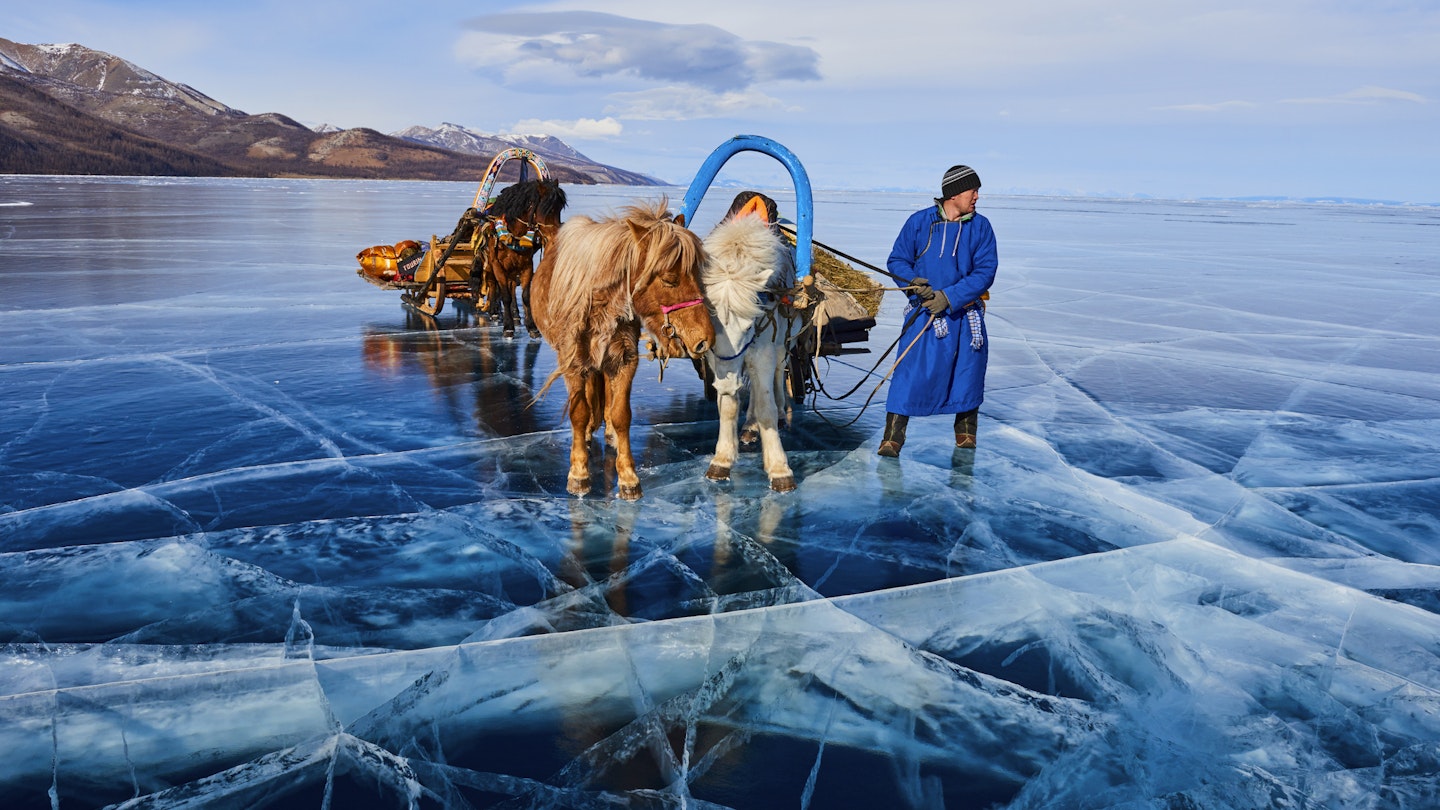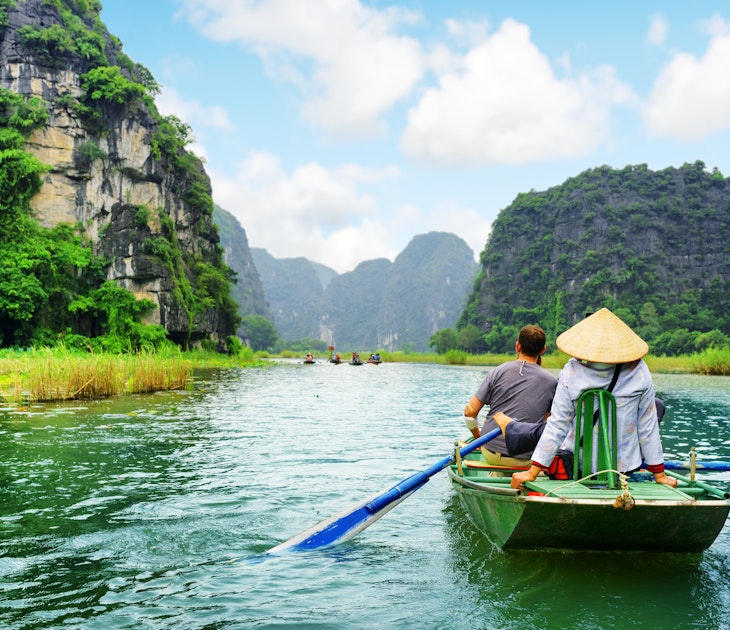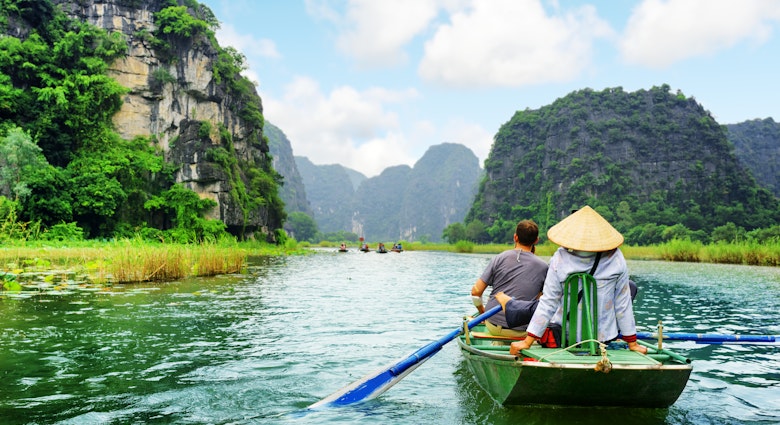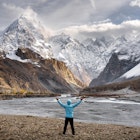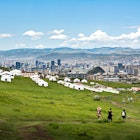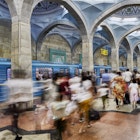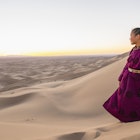Famed as the birthplace of Chinggis (Genghis) Khaan, Mongolia will make you feel like you are on another planet, with its ancient nomadic culture, endless blue skies, and wild and untouched natural environment.
In today’s rapidly changing world, Mongolia stands eternal – a land of lush valleys, turquoise lakes, scenic canyons, water marshes, sand dunes, snow-capped mountains, rolling grasslands and alpine forests, as well as customs and traditions that have been preserved for centuries.
With 21 provinces and 330 soums (subdistricts) and an area of 1.56 million square kilometers, Mongolia is the world’s most sparsely populated country, home to just 3.4 million people in an area three times larger than France. It’s important to pay close attention to planning your itinerary and travel days, as well as preparing for the local conditions, particularly the weather and the long distances between soums.
Moving from north to south, the country can be divided into four zones: the mountain forest, the alpine steppe; and in the far south, regions of semi-desert and the harsh desert landscapes of the Gobi. Each province and region has its own unique natural features, so it can be challenging for tourists to choose a destination among the many hidden treasures in this remarkable country. To help you decide, we've gathered together our 12 must-see sites in Mongolia.
1. Bayanzurkh, Khövsgöl
Best place for pristine nature
The blue freshwater lake of Khövsgöl Nuur is very often the first place travelers see in Khövsgöl Province in the northern part of Mongolia. And the majority don’t go beyond this corner of the province, which is a shame as there are many more incredible places in other parts of Khövsgöl.
Located 160km (99 miles) from the lake, the Bayanzürkh region is definitely worth visiting – pristine rivers and the Ushir waterfall flow down the sides of high, dramatic cliffs near the rocky spires of Boshloi Rock. Locals call it heaven on earth and it deserves a place on your bucket list.
Planning tip: A paved road runs from Ulaanbaatar to the shores of Khövsgöl Nuur, but you’ll need a 4WD vehicle to explore Bayanzürkh.
2. East Taiga
Best place for wild adventure
Another of Khövsgöl Province’s lesser-known secrets is East Taiga, the home of the Tsaatan people, Mongolia’s traditional reindeer herders. While you’ll have to drive for more than 10 hours on bumpy, muddy mountain roads and make a difficult 60km (37 miles) journey on horseback to reach this site, you’ll be too busy marveling at the magnificent mountains and crystal clear rivers of this untouched region to mind. You can also visit the thundering, 25m-tall Urtun Khyarkhyn waterfall, which is seen by few outsiders. Be prepared for a big adventure that requires a little patience!
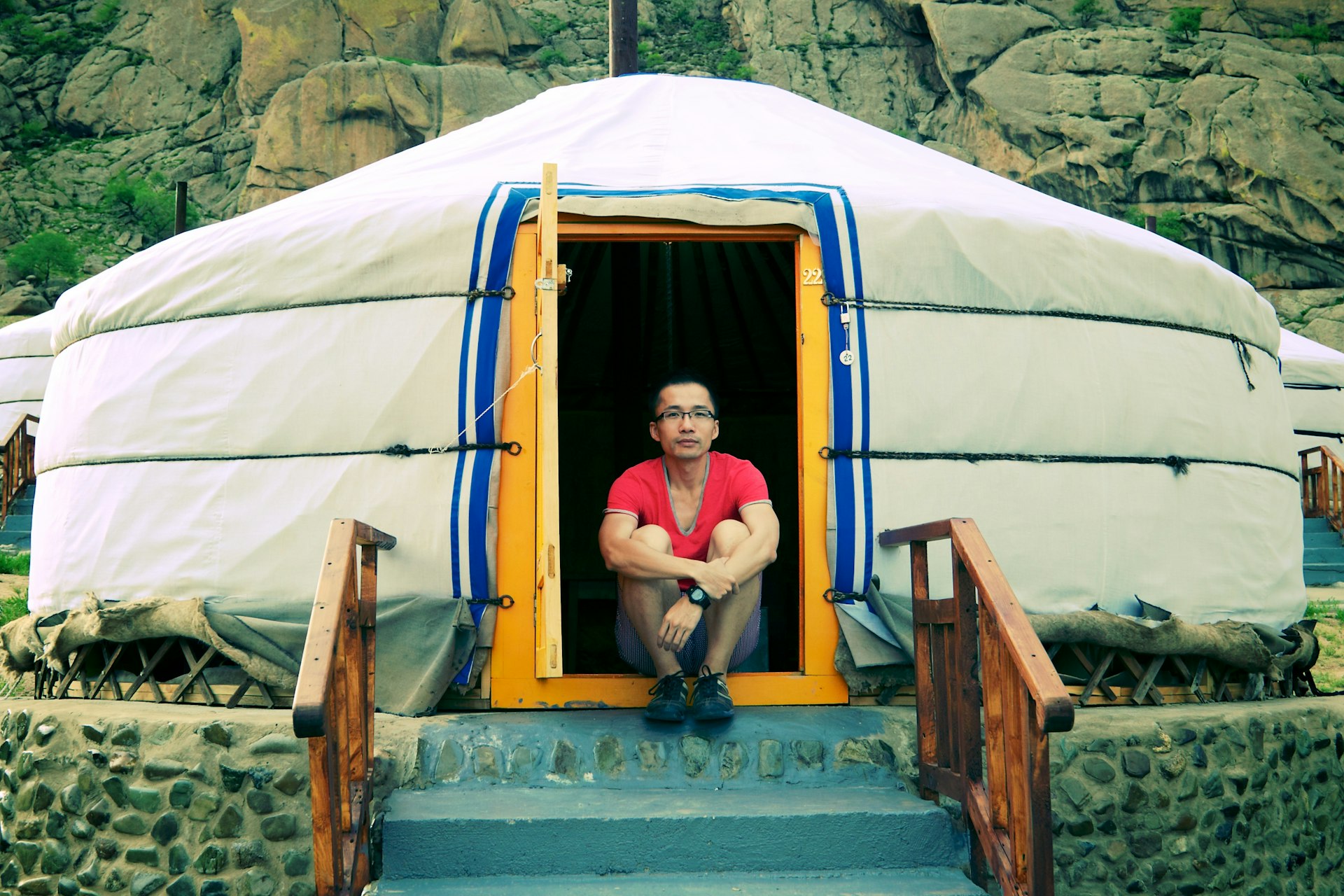
3. Tsenkher Hot Springs
Best place to relax
You can enjoy beautiful views of forested hills while relaxing in outdoor pools, or recharge in steaming indoor baths at the Tsenkher Hot Spring, which is open for all seasons, including winter. Naturally heated to 85C (185F), this is the second hottest spring in Mongolia after Shargaljuut, located at the foot of a forested mountain about 30km (18 miles) south of Tsetserleg city in Tsenkher soum. Locals believe the hot springs are good for treating rheumatism, neuralgia, muscular pain and arthralgia, improving the digestive system and restoring immunity after surgery.
Planning tip: Accommodation at Tsenkher Hot Springs is in ger camps; the popular Duut Resort is the most comfortable spot, with its own pools and accommodation in gers or a cozy wooden lodge.
4. Ikh Gazryn Chuluu
Most interesting cultural site
If your eyes grow tired of the sand dunes in the Gobi, the rocky, granite mountains of Ikh Gazryn Chuluu will give you a wonderful feeling of immersion into desert culture. There are many interesting stories about the people who lived or took shelter in the caves of this rugged range, and you can hear them at the theater dedicated to Mongolia’s tradition of the “long song” – epic, chanted folk songs that can last several hours. Visit in August to see the Uyakhan Zambuu Tiviin Naran Art Festival and experience Mongolia’s rich culture surrounded by peaceful and captivating nature.
Planning tip: The Ikh Gazryn Chuluu mountains are spread over an area of 20 sq km (7.7 sq miles) in Dundgovi Province, south of Ulaanbaatar; with a hired vehicle, you can get here via road from Mandalgovi in about an hour.
5. Khentii Province
Best place for walking in the footsteps of Chinggis Khan
Khentii Province has many historical places to pique the curiosity of those interested in the life of Mongolia’s greatest leader. There are numerous sites linked to the life of Chinggis Khan, including Khökh Nuur (the lake where Temujin was crowned as Chinggis Khan in 1206 CE), the Ikh Palace of Chinggis Khan, the Deluun Boldog (marking the great Khan’s birthplace) and the Gundgavirlan monastery.
Planning tip: Kentii province is situated in a region of great natural beauty, yet it’s only a one-day, 331km (205 miles) drive from Ulaanbaatar to Chinggis, the provincial capital. On the way, visit the country’s most famous Chinggis Khan Statue, just off the main road between Nalaikh and Erdene.
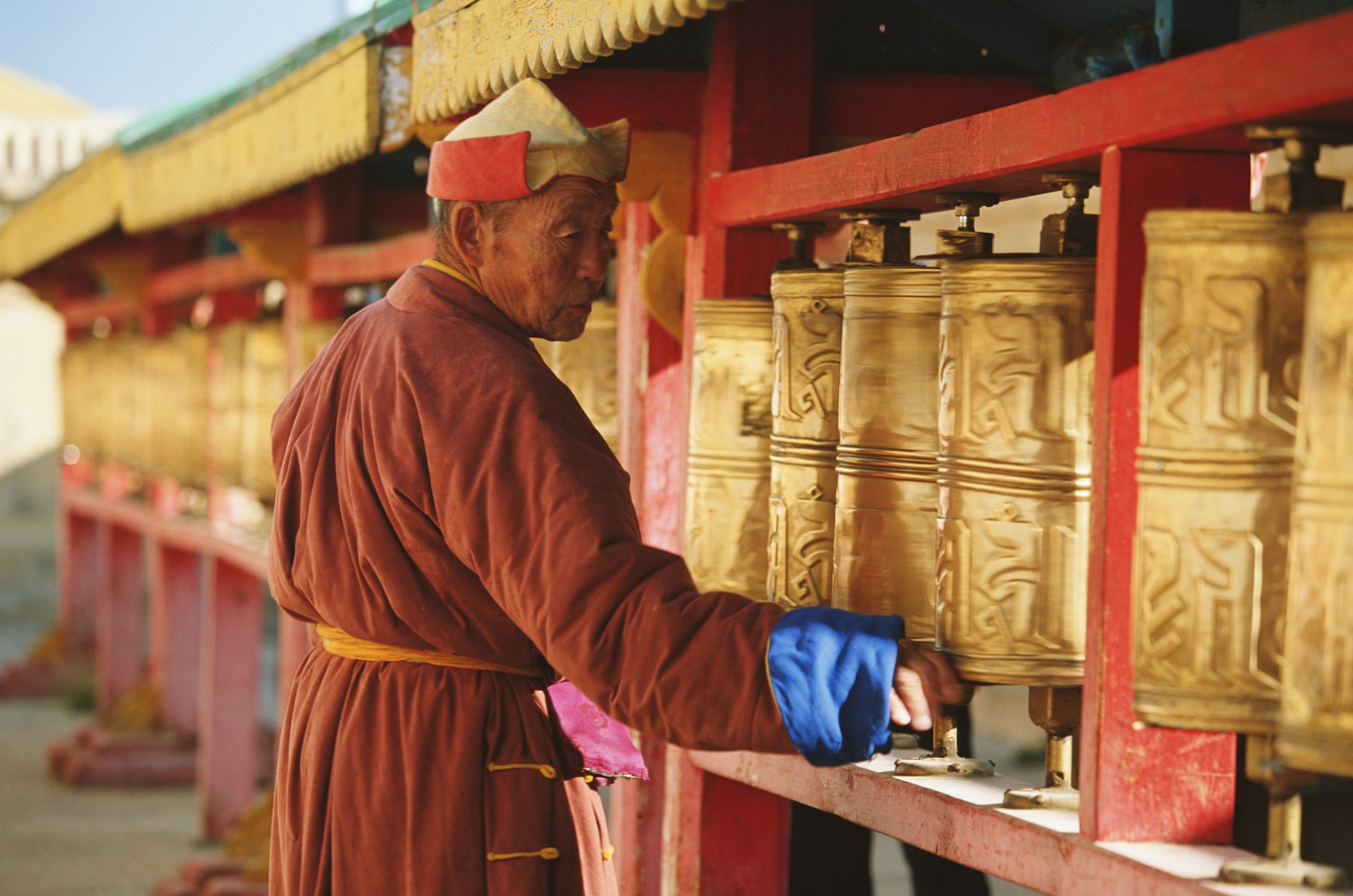
6. Tövkhön Khiid Monastery
Best place for meditating
Tövkhön Khiid is one of the prettiest, most intricately designed monasteries in the country. Located in an area of dense forests amidst picturesque mountains, 70km (43 miles) from Kharkhorin at an elevation of 200m (656ft), it’s quite unlike any other monastery complex in the country.
Zanabazar, who was the first leader of Buddhism in Mongolia, founded the monastery and lived and meditated here, calling it the “Land of Happy Solitude.” There are several nearby temples and a meditation cave to explore.
7. Gobi Gurvansaikhan National Park
Best place for desert landscapes
Mongolia’s most famous attraction is undoubtedly the Gobi desert, where you can trek or ride a horse or camel, surrounded by magnificent views. Gobi Gurvan Saikhan National Park in Umnugovi Province is one big playground for outdoor enthusiasts and a place to enjoy the harsh but uplifting landscape inhabited by Mongolia’s nomads.
The park is most famous for the dunes of Khongoryn Els, known as the “Singing Sands” because of the sound made by the shifting sand during strong winds. Another popular spot in the park is Yolyn Am, a dramatic gorge that is at its most stunning during winter when it’s filled with ice.
8. Kherkhruu Three Lakes
Best place to escape the crowds
Located around 180km (111 miles) from Ulaanbaatar in the Erdene soum of Tuv Province, the Kherkhruu Three Lakes (also known as Kherkhluur Saridag) offer a true wilderness experience. This untarnished place is set in the middle of high cliffs, surrounded by dense forests, and the road is lined with marshes, small rivers and willows. It’s a serene spot and the few travelers who visit mostly get here on horseback or by helicopter. As not everyone can go, this is one of the places that Mongolian tourists want to visit the most.
Planning tip: The Three Lakes lie within the Khan Khentii Strictly Protected Area; look out for moose, brown bears and 250 species of birds as you explore.
9. Saikhanii Khutul
Best place to go by train
Mongolia’s railways go in only two directions: from north to south and from south to north, linking Mongolia, Russia and China. Train enthusiasts who want to see unforgettable views of high, forested mountains and the life of nomadic families and country farmers are recommended to travel by train from Ulaanbaatar to Selenge Province in the northern part of the country.
Less than 10km (6.2 miles) from the provincial capital, Sükhbaatar, you can visit Saikhanii Khutul, a mountainous area with spectacular views over the Orkhon and Selenge river basins.
Planning tip: Trans Mongolian Railways trains to Russia are currently suspended because of the war in Ukraine, but local trains run from Ulaanbaatar to Sükhbaatar via Darkhan.

10. Khuiten Uul
Best place for trekking
Altai Tavan Bogd National Park, located 1920km (1193 miles) from Ulaanbaatar in Bayan-Ulgii Province, is a dream destination for trekkers, mountaineers, and wildlife and nature lovers. Not only is the national park rich in nature, but the surrounding area is also home to varied ethnic groups and fascinating historical sites. The highest peak at Altai Tavan Bogd is snow-capped Khuiten Uul (4374m/14,350ft), the highest point in all of Mongolia, which is accessible to experienced mountaineers on organized expeditions.
You also can't miss the Shiveet Khairkhan petroglyphs, listed as a World Cultural Heritage site by Unesco. The rock drawings cover varied subjects, from wild animals to figures on horseback and cover a huge area; the earliest were created at the beginning of the Bronze Age.
Planning tip: For a taste of the mountains, the trek to Khuiten Uul Base Camp from the Tsagaan Gol Valley (accessible by vehicle from Ölgii) is a rewarding day hike. On your way from town to the park, you can visit the White River and historical ruins and Kazakh eagle hunters.
11. Tsagaan Suvarga
Best place for landscape photographers
Dundgovi Province may seem like a sleepy place with not much to see, but the area has so much more to offer than it seems. In particular, it’s worth taking a trip to explore the incredible badlands at Tsagaan Suvarga, known as the “Grand Canyon of Mongolia” and reminiscent of the surface of Mars.
The cliff walls are more than 60m (197ft) tall at their highest point, and the canyon continues for 400m (1312ft). From a distance, it looks like the ruins of a city or a vast building, but looking from above will take you back to a time before humanity existed when this area was home to dinosaurs and other giant animals. In addition to wild sedges, grasses and buckwheat, the valley is rich in other Gobi plants, such as sagebrush and wild leeks.
12. Ulaanbaatar
Best for city experiences
You may have heard that the Mongolian summer is delightful, but even in winter, traveling to the world’s coldest capital city will give you a challenging yet unique experience. Ulaanbaatar has a reputation for traffic congestion and winter smog, but you don’t have to spend a lot of time outdoors.
The warm museums of this sprawling city will take you on a fascinating cultural and historical tour; must-visits include the Chinggis Khaan National Museum, devoted to the great Khan, and the Winter Palace of the Bogd Khaan, once home to Mongolia’s last king, Bogdo Jebtsundamba Khutuktu.
Planning tip: If you’d rather visit in the summertime, Naadam, the nation’s biggest festival, takes place in July. Big crowds gather at the Central Stadium, but many foreign tourists miss the action at the Khui Doloon Khudag horse racing ground outside the city; head here to see how real locals celebrate the festival!

